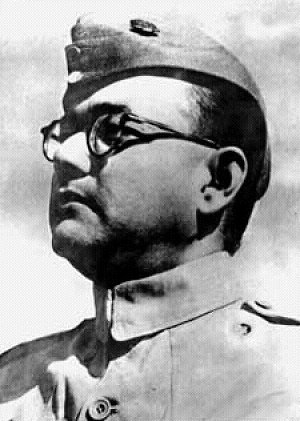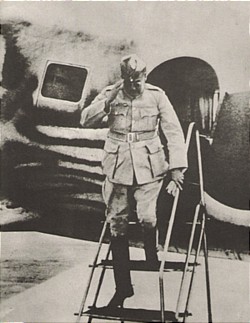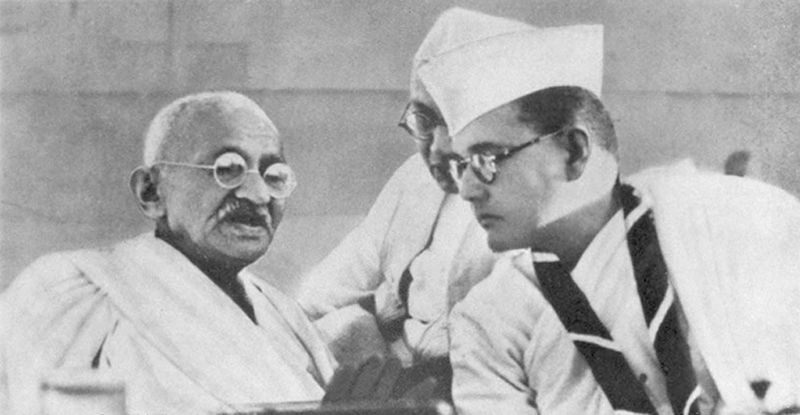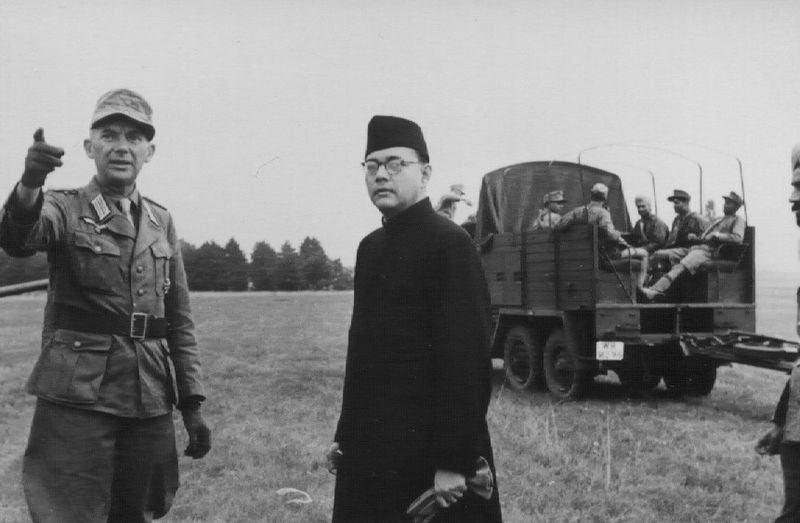<Back to Index>
- Physicist Paul Langevin, 1872
- Painter Édouard Manet, 1832
- President of the Indian National Congress Subhas Chandra Bose, 1897
PAGE SPONSOR


Subhas Chandra Bose (born 23 January 1897; presumed to have died 18 August 1945, although this is disputed), popularly known as Netaji (literally "Respected Leader"), was one of the greatest leaders in the Indian independence movement.
Bose
advocated complete freedom for India at the earliest, whereas the
Congress Committee wanted it in phases, through a Dominion status.
Other younger leaders including Jawaharlal Nehru supported Bose and
finally at the historic Lahore Congress convention, the Congress had to
adopt Purna Swaraj (complete freedom) as its motto. Bhagat Singh's martyrdom and the inability of the Congress leaders to save his life infuriated Bose and he started a movement opposing the Gandhi-Irwin Pact.
He was imprisoned and expelled from India. But defying the ban, he came
back to India and was imprisoned again. Bose was elected president of
the Indian National Congress for two consecutive terms, but had to resign from the post following ideological conflicts with Mahatma Gandhi and
after openly attacking the Congress' foreign and internal policies.
Bose believed that Mahatma Gandhi's tactics of non-violence would never
be sufficient to secure India's independence, and advocated violent
resistance. He established a separate political party, the All India Forward Bloc and
continued to call for the full and immediate independence of India from
British rule. He was imprisoned by the British authorities eleven
times. His famous motto was "Give me blood and I will give you freedom". His stance did not change with the outbreak of the Second World War,
which he saw as an opportunity to take advantage of British weakness.
At the outset of the war, he left India, travelling to the Soviet Union, Germany and Japan,
seeking an alliance with the aim of attacking the British in India.
With Japanese assistance, he re-organised and later led the Azad Hind Fauj or Indian National Army, formed from Indian prisoners of war and plantation workers from British Malaya, Singapore, and other parts of Southeast Asia, against British forces. With Japanese monetary, political, diplomatic and military assistance, he formed the Azad Hind Government in exile, regrouped and led the Indian National Army in battle against the allies at Imphal and in Burma. His political views and the alliances he made with Nazi and
other militarist regimes at war with Britain have been the cause of
arguments among historians and politicians, with some accusing him of
fascist sympathies, while others in India have been more sympathetic
towards the inculcation of realpolitik as a manifesto that guided his social and political choices.He is presumed to have died on 18 August 1945 in a plane crash over Taiwan. However, contradictory evidence exists regarding his death in the accident. Subhash Chandra Bose was born in a Bengali Kayasth family on January 23, 1897 in Cuttack (Odia Bazar), Orissa,
the ninth child among 14, of Janakinath Bose, an advocate, and
Prabhavati Devi. Bose studied in an Anglo school at Cuttack until
standard 6 which is now known as Stewart School and then shifted to
Ravenshaw Collegiate School of Cuttack. A brilliant student, Bose
topped the matriculation examination of Calcutta province in 1911 and
passed his B.A. in 1918 in Philosophy from the Scottish Church College of the University of Calcutta. Bose went to study in Fitzwilliam Hall of the University of Cambridge,
and his high score in the Civil Service examinations meant an almost
automatic appointment. He then took his first conscious step as a
revolutionary and resigned the appointment on the premise that the
"best way to end a government is to withdraw from it". At the time,
Indian nationalists were shocked and outraged because of the Amritsar massacre and the repressive Rowlatt legislation of 1919. Returning to India, Bose wrote for the newspaper Swaraj and took charge of publicity for the Bengal Provincial Congress Committee. His mentor was Chittaranjan Das, spokesman for aggressive nationalism in Bengal. Bose worked for Das when the latter was elected mayor of Calcutta in
1924. In a roundup of nationalists in 1925, Bose was arrested and sent
to prison in Mandalay, where he contracted tuberculosis Released from prison two years later, Bose became general secretary of the Congress party and worked with Jawaharlal Nehru for independence. Again Bose was arrested and jailed for civil disobedience; this time he emerged Mayor of Calcutta. During the mid 1930s Bose traveled in Europe, visiting Indian students and European politicians, as well as Hitler in 1942. He observed party organization and saw communism and fascism in action. By
1938 Bose had become a leader of national stature and agreed to accept
nomination as Congress president. He stood for unqualified Swaraj (independence), including the use of force against the British. This meant a confrontation with Mohandas Gandhi, who in fact opposed Bose's presidency, splitting the Congress party.
Bose attempted to maintain unity, but Gandhi advised Bose to form his
own cabinet. The rift also divided Bose and Nehru. Bose appeared at the
1939 Congress meeting on a stretcher. Though he was elected president
again, over Gandhi's preferred candidate Pattabhi Sitaramayya,
U Muthuramalingam Thevar strongly supported Bose in the intra-Congress
dispute. Thevar mobilised all south India votes for Bose. However, due
to
the manoeuvrings of the Gandhi-led clique in the Congress Working
Committee, Bose found himself forced to resign from the Congress
Presidency. His uncompromising stand finally cut him off from the
mainstream of Indian nationalism. Bose then organized the Forward Bloc on
June 22, aimed at consolidating the political left, but its main
strength was in his home state, Bengal. U Muthuramalingam Thevar, who
was disillusioned by the official Congress leadership which had not
revoked the CTA, joined the Forward Bloc. When Bose visited Madurai on
September 6, Thevar organised a massive rally as his reception. Bose
advocated the approach that the political instability of war-time
Britain should be taken advantage of — rather than simply wait for the
British to grant independence after the end of the war (which was the
view of Gandhi, Nehru and a section of the Congress leadership at the
time). In this, he was influenced by the examples of Italian statesmen
Giuseppe Garibaldi and Giuseppe Mazzini. His
correspondence reveals that despite his clear dislike for British
subjugation, he was deeply impressed by their methodical and systematic
approach and their steadfastly disciplinarian outlook towards life. In
England, he exchanged ideas on the future of India with British Labour
Party leaders and political thinkers like Lord Halifax, George
Lansbury, Clement Attlee, Arthur Greenwood, Harold Laski, J.B.S.
Haldane, Ivor Jennings, G.D.H. Cole, Gilbert Murray and Sir Stafford
Cripps . He came to believe that a free India needed Socialist
authoritarianism, on the lines of Turkey's Kemal Atatürk, for at
least two decades. Bose was refused permission by the British
authorities to meet Mr. Ataturk at Ankara for political reasons. It
should be noted that during his sojourn in England, only the Labour
Party and Liberal politicians agreed to meet with Bose when he tried to
schedule appointments. Conservative Party officials refused to meet
Bose or show him the slightest courtesy due to the fact that he was a
politician coming from a colony, but it may also be recalled that in
the 1930s leading figures in the Conservative Party had opposed even
Dominion status for India. It may also be observed here that it was
during the regime of the Labour Party (1945 - 1951), with Attlee as the
Prime Minister, that India gained independence. On
the outbreak of war, Bose advocated a campaign of mass civil
disobedience to protest against Viceroy Lord Linlithgow's decision to
declare war on India's behalf without consulting the Congress
leadership. Having failed to persuade Gandhi of the necessity of this,
Bose organised mass protests in Calcutta calling for the 'Holwell
Monument' commemorating the Black Hole of Calcutta, which then stood at
the corner of Dalhousie Square, to be removed. A
reasonable measure of the contrast between Gandhi and Bose is captured
in a saying attributable to him: "If people slap you once, slap them
twice". He was thrown in jail by the British, but was released
following a seven-day hunger strike. Bose's house in Calcutta was kept
under surveillance by the CBI, but their vigilance left a good deal to
be desired. With two court cases pending, he felt the British would not
let him leave the country before the end of the war. This set the scene
for Bose's escape to Germany, via Afghanistan and the Soviet Union.On
the night of his escape he dressed as a pathan left his house under
strict observation. Bose had never been to Afghanistan, and could not
speak the local tribal language (Pashto). Bose
escaped from under British surveillance at his house in Calcutta. On
January 19, 1941, accompanied by his nephew Sisir K. Bose, Bose gave
his watchers the slip and journeyed to Peshawar. With the assistance of
the Abwehr, he made his way to Peshawar where he was met at Peshawar
Cantonment station by Akbar Shah, Mohammed Shah and Bhagat Ram Talwar.
Bose was taken to the home of Abad Khan, a trusted friend of Akbar
Shah's. On 26 January 1941, Bose began his journey to reach Russia
through India's North West frontier with Afghanistan. For this reason,
he enlisted the help of Mian Akbar Shah, then a Forward Bloc leader in
the North-West Frontier Province. Shah had been out of India en route
to the Soviet Union, and suggested a novel disguise for Bose to assume.
Since Bose could not speak one word of Pashto, it would make him an
easy target of Pashto speakers working for the British. For this
reason, Shah suggested that Bose act deaf and dumb, and let his beard
grow to mimic those of the tribesmen. Supporters
of the Aga Khan helped him across the border into Afghanistan where he
was met by an Abwehr unit posing as a party of road construction
engineers from the Organization Todt who then aided his passage across
Afghanistan via Kabul to the border with Soviet Russia. Once in Russia
the NKVD transported Bose to Moscow where he hoped that Russia's
traditional enmity to British rule in India would result in support for
his plans for a popular rising in India. However, Bose found the
Soviets' response disappointing and was rapidly passed over to the
German Ambassador in Moscow, Count von der Schulenburg. He had Bose
flown on to Berlin in a special courier aircraft at the beginning of
April where he was to receive a more favourable hearing from Joachim
von Ribbentrop and the Foreign Ministry officials at the
Wilhelmstrasse. In
1941, when the British learned that Bose had sought the support of the
Axis Powers, they ordered their agents to intercept and assassinate
Bose before he reached Germany. A recently declassified intelligence
document refers to a top-secret instruction to the Special Operations
Executive (SOE) of British intelligence department to murder Bose. In
fact, the plan to liquidate Bose has few known parallels, and appears
to be a last desperate measure against a man who had thrown the British
Empire into a panic. Having escaped incarceration at home by
assuming the guise of a Pashtun insurance agent ("Ziaudddin") to reach
Afghanistan, Bose travelled to Moscow on the passport of an Italian
nobleman "Count Orlando Mazzotta". From Moscow, he reached Rome, and
from there he travelled to Germany, where he instituted the Special
Bureau for India under Adam von Trott zu Solz, broadcasting on the
German sponsored Azad Hind Radio. He founded the Free India Centre in
Berlin, and created the Indian Legion (consisting of some 4500
soldiers) out of Indian prisoners of war who had previously fought for
the British in North Africa prior to their capture by Axis forces. The
Indian Legion was attached to the Wehrmacht, and later transferred to
the Waffen SS. Its members swore the following allegiance to Hitler
and Bose: "I swear by God this holy oath that I will obey the leader of
the German race and state, Adolf Hitler, as the commander of the German
armed forces in the fight for India, whose leader is Subhas Chandra
Bose". This oath clearly abrogates control of the Indian legion to
the German armed forces whilst stating Bose's overall leadership of
India. He was also, however, prepared to envisage an invasion of India
via the U.S.S.R. by Nazi troops, spearheaded by the Azad Hind Legion;
many have questioned his judgment here, as it seems unlikely that the
Germans could have been easily persuaded to leave after such an
invasion, which might also have resulted in an Axis victory in the
War. The
lack of interest shown by Hitler in the cause of Indian independence
eventually caused Bose to become disillusioned with Hitler and he
decided to leave Nazi Germany in 1943. Bose had been living together
with his wife Emilie Schenkl in Berlin from 1941 until 1943, when he
left for south-east Asia. He travelled by the German submarine U-180
around the Cape of Good Hope to Imperial Japan (via Japanese submarine
I-29). Thereafter the Japanese helped him raise his army in Singapore.
This was the only civilian transfer across two submarines of two
different navies in World War II. The Indian National Army (INA) was
originally
founded by Capt Mohan Singh in Singapore in September 1942 with Japan's
Indian POWs in the Far East. This was along the concept of — and with
support of — what was then known as the Indian Independence League,
headed by expatriate nationalist leader Rash Behari Bose. The first INA
was however disbanded in December 1942 after disagreements between the
Hikari Kikan and Mohan Singh, who came to believe that the Japanese
High Command was using the INA as a mere pawn and Propaganda tool.
Mohan Singh was taken into custody and the troops returned to the
Prisoner of War camp. However, the idea of a liberation army was
revived with the arrival of Subhas Chandra Bose in the Far East in
1943. In July, at a meeting in Singapore, Rash Behari Bose handed over
control of the organisation to Subhas Chandra Bose. Bose was able to
reorganise the fledging army and organise massive support among the
expatriate Indian population in south-east Asia, who lent their support
by both enlisting in the Indian National Army, as well as financially
in response to Bose's calls for sacrifice for the national cause. At
its height it consisted of some 85,000 regular troops,
including a separate women's unit, the Rani of Jhansi Regiment (named
after Rani Lakshmi Bai) headed by Capt. Laxmi Vishwananthan, which is
seen as a first of its kind in Asia. Even
when faced with military reverses, Bose was able to maintain support
for the Azad Hind movement. Spoken as a part of a motivational speech
for the Indian National Army at a rally of Indians in Burma on July 4,
1944, Bose's most famous quote was "Give me blood, and I shall give you
freedom!" . In this, he urged the people of India to join him in his
fight against the British Raj. Spoken in Hindi, Bose's words are highly
evocative. The troops of the INA were under the aegis of a provisional
government, the Azad Hind Government, which came to produce its own
currency, postage stamps, court and civil code, and was recognised by
nine Axis states — Germany, Japan, Italy, the Independent State of
Croatia, Wang Jingwei's Government in Nanjing, Thailand, a provisional
government of Burma, Manchukuo and Japanese controlled Philippines.
Recent researches have shown that the USSR too had recognised the
"Provisional Government of Free India". Of those countries, five were
authorities established under Axis occupation. This government
participated in the so-called Greater East Asia Conference as a observer in November 1943. The
INA's first commitment was in the Japanese thrust towards Eastern
Indian frontiers of Manipur. INA's special forces, the Bahadur Group,
were extensively involved in operations behind enemy lines both during
the diversionary attacks in Arakan, as well as the Japanese thrust
towards Imphal and Kohima, along with the Burmese National Army led by
Ba Maw and Aung San. A year after the islands were taken by the
Japanese, the Provisional Government and the INA were established in
the Andaman and Nicobar Islands with Lt Col. A.D. Loganathan appointed
its Governor General. The islands were renamed Shaheed (Martyr) and
Swaraj (Self-rule). However, the Japanese Navy remained in essential
control of the island's administration. During Bose's only visit to the
islands in late in 1943, when he was carefully screened from the local
population by the Japanese authorities, who at that time were torturing
the leader of the Indian Independence League on the Islands, Dr. Diwan
Singh (who later died of his injuries, in the Cellular Jail). The
islanders made several attempts to alert Bose to their plight, but
apparently without success. Enraged with the lack of administrative
control, Lt. Col Loganathan later relinquished his authority to return
to the Government's head quarters in Rangoon. On
the Indian mainland, an Indian Tricolour, modelled after that of the
Indian National Congress, was raised for the first time in the town in
Moirang, in Manipur, in north-eastern India. The towns of Kohima and
Imphal were placed under siege by divisions of the Japanese, Burmese
and the Gandhi and Nehru Brigades of I.N.A. during the attempted
invasion of India, also known as Operation U-GO. However, Commonwealth
forces held both positions and then counter-attacked, in the process
inflicting serious losses on the besieging forces, which were then
forced to retreat back into Burma. Bose
had hoped that large numbers of soldiers would desert from the Indian
Army when they would discover that INA soldiers were attacking British
India from the outside. However, this did not materialise on a
sufficient scale. Instead, as the war situation worsened for the
Japanese, troops began to desert from the INA. At the same time
Japanese funding for the army diminished, and Bose was forced to raise
taxes on the Indian populations of Malaysia and Singapore, sometimes
extracting money by force. When the Japanese were defeated at the
battles of Kohima and Imphal, the Provisional Government's aim of
establishing a base in mainland India was lost forever. The INA was
forced to pull back, along with the retreating Japanese army, and
fought in key battles against the British Indian Army in its Burma
campaign, notable in Meiktilla, Mandalay, Pegu, Nyangyu and Mount Popa.
However, with the fall of Rangoon, Bose's government ceased be an
effective political entitiy. A large proportion of the INA troops
surrendered under Lt Col Loganathan when Rangoon fell. The remaining
troops retreated with Bose towards Malaya or made for Thailand. Japan's
surrender at the end of the war also led to the eventual surrender of
the Indian National Army, when the troops of the British Indian Army
were repatriated to India and some tried for treason. In a speech broadcast by the Azad Hind Radio from Singapore on July 6, 1944, Bose addressed Mahatma Gandhi as the "Father of the Nation". This was the first time that Mahatma Gandhi was referred to by this appellation. His
other famous quote was, "Chalo Delhi", meaning "On to Delhi!". This was
the call he used to give the INA armies to motivate them. "Jai Hind",
or, "Glory to India!" was another slogan used by him and later adopted
by the Government of India and the Indian Armed Forces.
Bose is alleged to have died in a plane crash over Taiwan, while flying to Tokyo on 18 August 1945. It is believed that he was en route to the Soviet Union in a Japanese plane when it crashed in Taiwan,
burning him fatally. However, his body was never recovered, and many
theories have been put forward concerning his possible survival. One
such claim is that Bose actually died later in Siberia, while in Soviet captivity. Several committees have been set up by the Government of India to probe
into this matter. In May 1956, a four-man Indian team (known as the
Shah Nawaz Committee) visited Japan to
probe the circumstances of Bose's alleged death. However, the Indian
government did not then request assistance from the government of Taiwan in the matter, citing their lack of diplomatic relations with Taiwan. However, the Inquiry Commission under Justice Mukherjee,
which investigated the Bose disappearance mystery in the period
1999 - 2005, did approach the Taiwanese government, and obtained
information from the Taiwan Government that no plane carrying Bose had
ever crashed in Taipei, and there was, in fact, no plane crash in
Taiwan on 18 August 1945 as alleged. The Mukherjee Commission also received a report originating from the U.S. Department of State supporting the claim of the Taiwan Government that no such air crash took place during that time frame. The
Justice Mukherjee Commission of Inquiry submitted its report to the
Indian Government on November 8, 2005. The report was tabled in
Parliament on May 17, 2006. The probe said in its report that as Bose
did not die in the plane crash, and that the ashes at the Renkoji
Temple (said to be of Bose's) are not his. However, the Indian
Government rejected the findings of the Commission, though no reasons
were cited. Several
documents which could perhaps provide lead to the disappearance of Bose
have not been declassified by the Government of India, the reason cited
being publication of these documents could sour India's relations with
some other countries.
Bose was posthumously awarded the Bharat Ratna, India's highest civilian award in 1992, but it was later withdrawn in response to a Supreme Court directive
following a Public Interest Litigation filed in the Court against the
"posthumous" nature of the award. The Award Committee could not give
conclusive evidence on Bose's death and thus the "posthumous" award was
invalidated. No headway was made on this issue however. Bose's portrait hangs in the Indian Parliament, and a statue of him has been erected in front of the West Bengal Legislative Assembly.
Several people believed that the Hindu sanyasi named Bhagwanji or 'Gumnami Baba', who lived in the house Ram Bhawan in Faizabad, UP at
least until 1985, was Subhas Chandra Bose in exile. There had been at
least four known occasions when Gumnami Baba reportedly claimed he was
Netaji Subhas Chandra Bose. The
belongings of the sanyasi were taken into custody after his death,
following a court order. These were later subjected to inspection by the Justice Mukherjee Commission of Inquiry. The commission came down against this belief, in the absence of any "clinching evidence". The independent probe done by the Hindustan Times into the case however provided hints that the monk was Bose himself. Some
people believe that Gumnami Baba died on 16 September 1985, while some
dispute this. The story of Gumnami Baba came to light on his death. It
is alleged that he was cremated in the dead of night, just under the
light of a motorcycle's headlamp, at Faizabad's popular picnic spot, on
the bank of River Saryu. His face distorted by acid to protect his
identity. Faizabad's Bengali community still pays homage at the
memorial built at his cremation site on the anniversary of his birth.
However, the life and activities of Bhagwanji remain a mystery even
today. Justice
Manoj Kumar Mukherjee who probed into the disappearance of Netaji
Subhas Chandra Bose stated in his report that the sanyasi of Faizabad (Bhagwanji)
was not Bose as there was no clinching evidence to prove it. However,
he inadvertently stated in a documentary shoot that he believed
Bhagwanji was none other than Bose. This revelation supports the view that Bose had not died in the plane crash in 1945, and was in fact in India after that.

